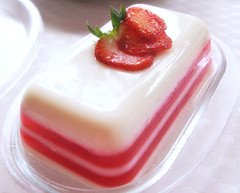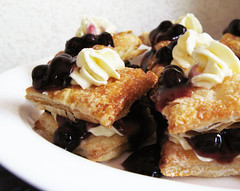St. Lily Peach Cake
(Torta di Pesca del Santa Giglia) I don't care if many people, or even my friends, think cake is overrated (or even downright revolting). I love cake. I would almost never turn down a slice of a cake I've never tasted before. I think there's plenty of unexplored territory with regards to the flavors, constructions, and combinations. The problem is that so few people bake. Therefore, many people, when a birthday comes along, buy cake. And they're afraid of buying a cake no one will eat, so they buy the same old chocolate cake, or to be adventurous, vanilla or coffe cake with whipped cream. Pretty soon everyone is tired of cake. This is compounded by the fact that to maximize output, giant cake chains will manufacture only 3 kinds of cake at the most-- vanilla, mocha, and chocolate, and 2 kinds of icing-- boiled (marshmallow) icing and buttercream. Then they pray that you will just find whatever action figure on top interesting. Then, people who are presented with a strange new cake will wonder if the reason they've never seen it before is that it tastes bad.
Flo Braker's book, The Simple Art of Perfect Baking, has never steered me wrong recipe-wise. The lady is a cake goddess. She has an incredibly simple recipe for cake: brown sugar génoise filled with peaches and frosted with whipped cream. The taste is surprisingly complex given the fact that the cake is imbibed with fresh, new flavors. And they go really well with peaches. The whipped cream is a cushion for the flavors, rather than an overly sweet icing that saves a bland cake. This is officially a birthday cake for my friend Faith who hates onions. I hope she liked it. I'm pretty sure she did. (Recipe follows)
Grease and line an 8-inch cake pan and preheat the oven to 175°C (350°F). Sift together 3/4 cup (75g) sifted cake flour, 1 tablespoon sugar, 1/2 teaspoon cinnamon, and 1/8 teaspoon salt; set aside. Whisk 3 tablespoons heavy cream in a small bowl until slightly thickened; set aside. In a large bowl over hot tap water (50°C/ 120°F), whisk together 2 large whole eggs, 2 large egg yolks, 1/4 cup (50g) light brown sugar, and 1/4 cup (50g) sugar for 30 seconds or until it has reached body temperature. It should be smooth and not feel granular when rubbed. Using a mixer, beat the eggs on medium until it is pale, thick, tripled in volume, and falls back in ribbons from the beaters without sinking immediately, about 3-4 minutes. Sprinkle in and fold the flour mixture into the eggs in 3 additions. Pour 1 cup of the batter into the whipped cream, then fold until combined. Return this to the rest of the batter and fold to combine.
Pour into the pan and spin the pan to create a slightly raised edge. Bake for 20-22 minutes until it sounds spongy when tapped, the sides are contracting, and the center springs back.
When cool, split in two and fill with whipped cream, slices from a blanched peach, then another layer of whipped cream. Frost the top and sides with more whipped cream.
As you can see, I made royal icing rosettes for the top. They were supposed to be lilies but I'm a doofus and I made the royal icing too thick. I squeezed the bag as hard as I could, but so help me I've never squeezed anything so stiff in my life. Only a little bit came out the tip after my forearms nearly fell out (I think there may have been shouting involved--- ARGGHHHH!!!). So I cut my losses and replaced the petal tip with a comfortable open star and just did my corny rosettes. Looks like those realistic flowers will have to wait... (and so will the how-to.)















































































